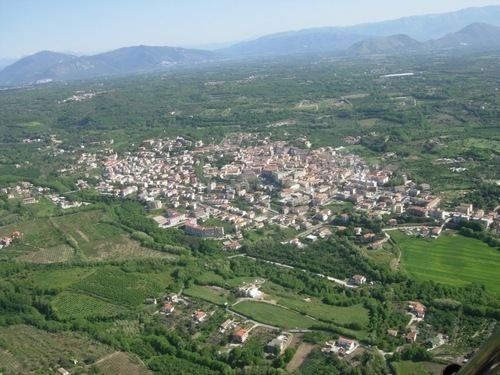Elevation 196 m (643 ft) Time zone CET (UTC+1) Dialling code 0823 | Demonym(s) Teanesi Area 88 km² Local time Tuesday 1:17 AM Postal code 81057 | |
 | ||
Frazioni Borgonuovo, Cappelle, Carbonara, Casafredda, Casale, Casamostra, Casi, Cipriani, Fontanelle, Furnolo, Gloriani, Magnano, Maiorisi, Pugliano, San Giulianeta, San Giuliano, San Marco, Santa Maria Versano, Taverna Zarone, Teano Scalo, Tranzi, Tuoro, Versano Weather 7°C, Wind NE at 10 km/h, 64% Humidity | ||
Teano is a town and comune in the province of Caserta, Campania, southern Italy, 30 kilometres (19 mi) northwest of Caserta on the main line to Rome from Naples. It stands at the southeast foot of an extinct volcano, Rocca Monfina.
Contents
- Map of 81057 Teano Province of Caserta Italy
- Ancient times and Middle Ages
- Handshake of Teano
- Main sights
- Transportation
- References
Map of 81057 Teano Province of Caserta, Italy
Ancient times and Middle Ages
The ancient Teanum Sidicinum was the capital of the Oscan tribe of the Sidicini, which drove the Aurunci from Roccamonfina. They probably submitted to Rome in 334 BC and their troops were grouped with those of Campania in the Roman army. Thus the garrison of Regium, which in 280 attacked the citizens, consisted of one cohort of Sidicini and two of Campanians. Like Cales, Teanum continued to have the right of coinage, and, like Suessa and Cales, remained faithful to Rome in both the Hannibalic and the Social wars. Its position gave it some military importance, and it was apparently made a colony by Claudius, not by Augustus. Strabo speaks of it as the most important town on the Via Latina, joined by a branch road from Suessa, of which remains still exist, and which continued east to Alife.
In the 4th century Teano became seat of a diocese, and was later an important Lombard county, as part of the Duchy of Benevento. The Benedictines had several property in the city, and here the monks from Montecassino took refuge when their abbey was destroyed in 883. Here one of the first document of vulgare Italian was issued in 963.
"Handshake of Teano"
Teano was the site of the famous meeting of 26 October 1860, between Italian nationalist fighter Giuseppe Garibaldi and Victor Emanuel II, the King of Sardinia. Having wrested the Kingdom of the Two Sicilies from the Neapolitan Bourbons, Garibaldi shook Victor Emanuel's hand and hailed him as King of Italy. Thus, Garibaldi sacrificed republican hopes for the sake of Italian unity under a monarchy. The event is a popular subject for Italian patriotic statues and paintings.
Main sights
Roman remains of Teano include the theatre (2nd century BC, rebuilt in the 2nd century AD), once one of the greatest in Italy with its 85 m of diameter, some extensive baths ("Le Caldarelle"), containing several statues, and some Roman dwellings. A tomb with a Christian mosaic representing the visit of the Three Wise Men to Bethlehem was found in 1907. Of the famous amphitheater, cited by several sources, no traces remain.
Other sights include:
Transportation
Teano is 7 kilometres (4 mi) from the gate of Capua of A1 Milan-Naples highway. It can be also reached by road through SS.7 Via Appia and SS.6 Via Casilina. The city is also served by a railway station.
